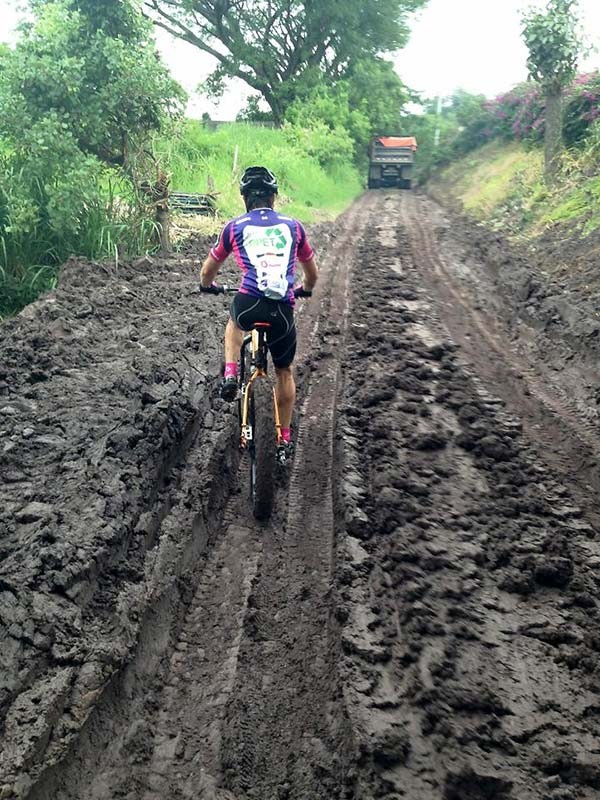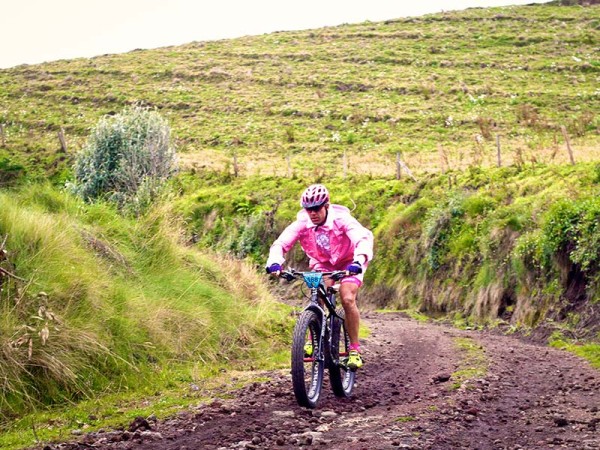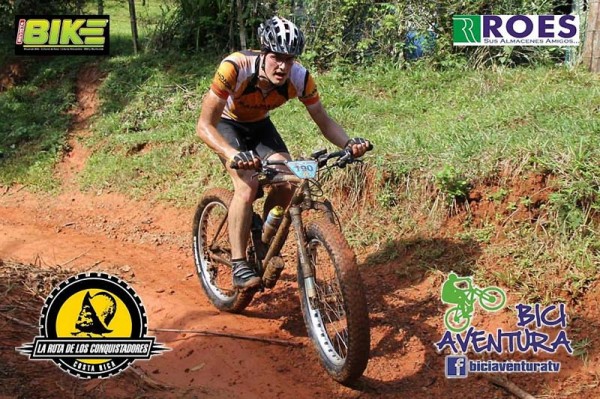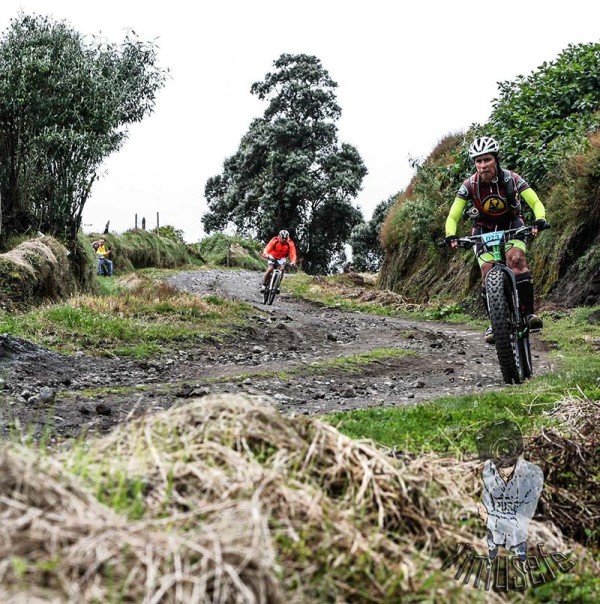This is continuing coverage of the Fat La Ruta race that was recently completed in Costa Rica. Thanks to Will Muecke of Team CoreCo for the story! You can see Part 1 of the Fat La Ruta coverage here.
MOUNTAINS OF THE MOON: FAT LA RUTA, DAY 2 (TERRAMALL TO CATIE, 80KM, +3,200M ASCENT)
Day 2 started out with a bit of a Costa Rican push. The elite riders coming from the hotel got hung up in traffic, so the race got underway 45 minutes later than scheduled. So much for the 3:30 am wake up.
Wide-eyed adrenaline stares turned to sleepy nods, and everyone found a spot of concrete in the starting pen to sit down and wait. Team CoreCo, wearing a mix of this year’s Fatbiker pink and purple kit and some of last year’s fluorescent jungle green motif, looked like a bag of spilled jellybeans among the seated crowd. Finally, the bus with the pros arrived and we were up on our feet and on our way.
Elias lined up with the pros at the start and so was our in the lead pack from the start. Jim Meyer was caught in the back behind some of the larger waves of riders leaving the starting chute and had to sprint up through a surging pack to catch Elias’ wheel. The tight turns in and out of the streets of Tres Rios where the Terramall start is located made for some big bunch ups in the pack, luckily none of them resulting in major crashes or snarl ups.
As the group ascended on the main blacktop road out of town the from group fractured and the pros were off in a hell-bent sprint to the summit of Irazu, a dormant volcanic cone that peaks at 3,800 meters above sea level, and is +2,000 meters above the Terramall start.
The fat-bikers were stoking it that morning. Marco, Elias and Wayne were cranking away at the front. Jim Meyer was hanging with them not yielding any time, with Ligia pulling up and ahead in the women’s overall group on her fat bike.
Ligia rode this stage multiple times on her fat-bike in training, and knew that there was an advantage to be gained in the big footprint tire as the group climbed into steeper terrain and approached what the race organizer, Roman, called his “surprise gift” for the racers that day: a section of off-road double track that exceeded 27-degrees in places and snaked up and thought the high volcanic coffee fields on the way to the summit.
Elias and Jim ripped into this section, and started putting distance between them and the rest of the field. Topping out at the summit, it was the two fat-bikers who tore down the backside of the mountain and passed many elite riders walking down the more dangerous, technical descents that Elias and Jim took at speed.
Much was the same story with the other fat-bike competitors. Cresting the summit and pointing the fatties downhill, you found yourself yelling “PERMISO!!” loud and often trying to clear the more cautious riders from the trail in front of you.
Almost the full first half of the day is a solid, straight up climb, the second half of the day, except for a short, stepped ascent over the top of the second (active) volcano of Turrialba, is all about the descent – all 90-minutes of it.
While the approach to Turrialba gives a view of the burnt shoulder of the mountain, its forests ashen from the searing heat of pyroclastic flows that spilled over and out earlier in the year, no rider really gets much tome to take in all of that gorgeous view.
The descent from Turrialba is a fast one for any rider, but that same descent on a fat-bike is a pure screamer. The last technical stretch of Turrialba’s descent is a downhill that most riders gingerly pick their way down on foot, but turned over to a competent pilot on a fat-bike, that same stretch is a high-speed playground.
I liken the use of a fat bike for these fast, technical descents is like using crud-busting powder ski on the backside of the mountain once you trek away from the boundaries of the lift-accessed pistes. And just like having multiple skis in your quiver so you can go from a skinny, front-side carver to a wide-waisted backcountry bomber, the choice of a fat-bike on these crazed descents gives you a set of tires that float more than bite, and a frameset and (carbon!) fork that rides like a possessed beast heading for home.
Coming out of the technical dirt tracks the final downhill kilometers are sweeping arcs of paved, linked S-turns. The hazard there is speed and loss of friction in the apex. A wet patch or mossy corner can send bike and rider airborne.
This is where our friend Dennis says that he nearly ate it and I can attest that he was pretty close to a race-ending error. But when ridden with focus and determination, these last turns are free speed and a friendly push from gravity to the home run across the finish line.
Here Elias and Jim cranked down and went for gold. Elias says that he never saw Jim on the backside of the mountain, but, for sure, Jim saw Elias and was gunning for him all the way to the tape. Elias crossed the finish in the #4 overall spot for the day in the Men’s Open category, and Jim came in a #5, two minutes behind Elias.
As a rider in the field, Elias was still #3 in the Overall Men’s category after Day 2, and it was looking like a possible podium finish for him, overall, in Playa Bonita the next afternoon.
Jim Meyer would need to come with his full weapon kit for Day 3 to knock Elias off the overall podium and to also move into the #1 slot in the Men’s Fat Bike category.
Ligia crossed the line in CATIE high in the Women’s Open standings and was also looking like a potential podium position to add to her #1 position in the Women’s Fat Bike category.
With these racehorses (Elias, Ligia, Jim and others) on their fat-bikes it was a proven fact that a fat-bike rider could best most, if not all, of the field in a race like La Ruta.
Our side bets were that if there were no pavement in a race such as La Ruta, fat-bikes would not be in the minority, but would rather, with some greater knowledge spread though the field, be the weapon of choice for ALL riders.
That still remains to be seen, but with weights on Ti and carbon bikes coming down to sub-12 or even sub-11 kgs, we would guess it is only a matter of time for this estimated outcome to have real-world results behind it.
Photos in this article were provided by the author and every effort was made to credit, or leave intact, the original images. Some resizing was necessary due to file size constraints. Also, the chronology of the images amy not match the exact day or time of the description in the article but all are from the event and are representative of the race conditions.





Bad ass!
My Gnarvester would eat it up!
But why is everyone so clean? Whenever I race in the mud, I can’t see me nor- the bike though the peanut butter.